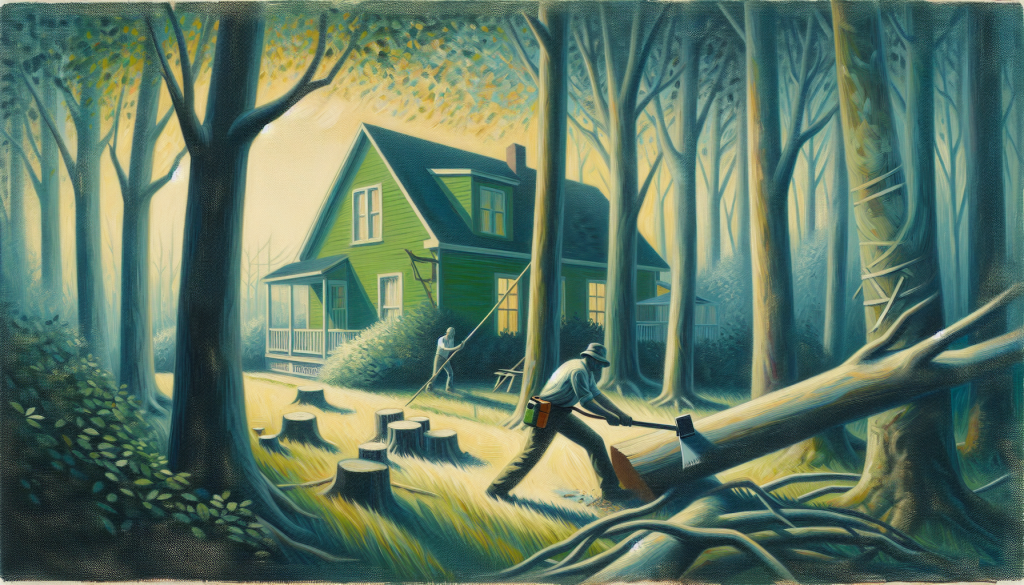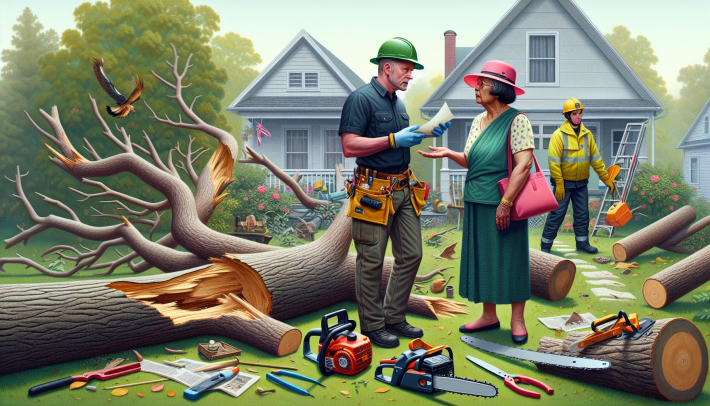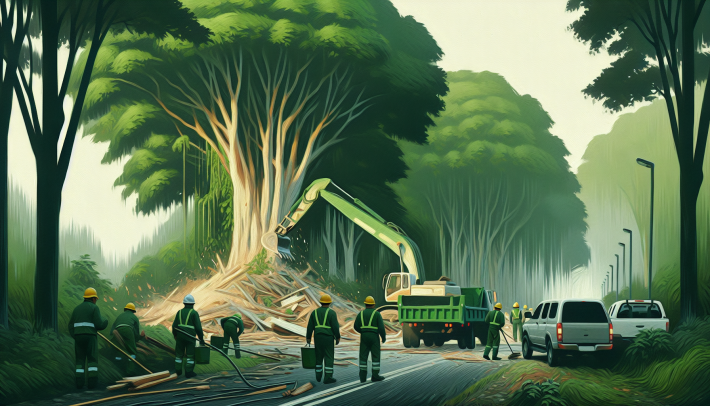Can you sue a neighbor for cutting your tree?

Understanding Property Disputes
Dealing with property disputes can feel like a real tightrope walk. And when trees are involved, the stakes can be as high as those towering oaks. So let’s break down why these leafy liabilities can cause such a ruckus.
Common Causes of Property Conflicts
Ever notice how prickly things get when you’re talking about property lines? Seems like about four out of ten feuds roomed right in the boundary confusion corner – like the last useless piece of the jigsaw puzzle no one can figure out (UpCounsel). Toss in a little home remodeling or neighborhood construction, and boom! There’s a 35% jump in these clashes over the past five years (UpCounsel).
When it comes to trees, we often face:
- Branches or roots that refuse to mind their own business
- Squabbles over who should be grooming these green giants
- That awkward moment when a mighty limb decides to play a game of gravity
Seems like establishing peace amidst the greenery requires us to get cozy with the exact do’s and don’ts on border behavior.
Importance of Boundary Verification
Before we dive into any neighborly nitpicking, setting the record straight on your property’s perimeter is pretty much essential. Think of it this way: if the neighbor’s chainsaw makes an unwelcome guest appearance on our side, we’ve got options. The smart play? Bring in the surveyors before rolling out the renovation party or planting new saplings.
We’ve got more than just one way to draw a clear line in the sand—or grass. Tech and tools exist to pin down precise boundaries, saving us from future headaches. For a deeper dive, check out our piece on how to determine if a tree is on your property or your neighbors property.
Grasping these angles of property disputes can lead to peace treaties and keep us away from courtroom drama. If we suspect something fishy and think our rights got trampled, a good question to ponder might be, “Can we sue someone for cutting down trees on our property?”
Legal Implications of Tree Removal
When it comes to our properties, knowing the ins and outs of tree removal laws is critical. Questions like, “Can we sue someone for cutting down trees on our property?” may arise, and there are indeed legal paths we can take. Here, we’ll dig into a case where someone took legal action over tree removal, touching on the possibility of snagging some compensation for such green misdeeds.
Case Study: Legal Action for Tree Removal
Imagine this: a neighbor hacks away at our trees without warning. So, what next? Well, the first step is figuring out how much those trees were worth. A stroll to the local nursery might give us a price tag, or perhaps a chat with a lumber company. Snapping some photos and saving receipts turns that price into solid proof.
Armed with these numbers, it’s time to let the neighbor know. A friendly—or not-so-friendly—letter demanding payback might do the trick, including those figures we’ve gathered. These records not just jog their memory but could also be key if things get serious in the legal ring.
Some states have laws on the books that let us claim damages if a neighbor takes a chainsaw to our trees. If they were really out of line, we might even wrangle punitive damages for their tree-chopping antics (Nolo).
Compensation for Illegal Tree Cutting
When somebody chops down our trees without permission, we could be looking at more than just a bill for timber. The hit could reach into the thousands, factoring in not only the wood’s worth but also the impact on our landscape and environment (Ohio State University Extension). We need to tally up all our losses to get a fair shake on compensation.
What might we consider?
| What We Lose | Why It Matters |
|---|---|
| Cash Value | Cost to replace those felled trees |
| Sentimental Attachment | Our personal bond with those leafy giants |
| Environmental Contributions | The trees’ role in keeping our world green |
| Visual Appeal | How our property’s charm takes a hit |
By recognizing all these potential losses, we can piece together a stronger case. And if figuring it all out leaves us scratching our heads, a lawyer with a knack for property disputes could be our best bet. For those with tree trouble next door, getting educated about handling dangerous trees in our neighbor’s yard or sorting out tree conflicts could really clear the air.
Timber Theft and Consequences
Impact of Timber Theft on Property Owners
Timber theft ain’t just a wallet issue—it tugs at the heartstrings, too. When folks sneak onto our land and ax our trees, the damage isn’t just to our bank accounts. According to Ohio State University Extension, these sneaky log raids can swipe tens to hundreds of thousands right from under us. We’re talkin’ about cash value, sure, but also the stuff you can’t put a price on: memories tied to those trees and the impact on the environment and scenery.
| Type of Loss | What’s at Stake |
|---|---|
| Monetary Value | The bucks our timber is worth |
| Sentimental Value | The stories and heartstrings attached to the trees |
| Environmental Value | The goodness trees bring to nature’s balance |
| Aesthetic Value | The knockout beauty trees give to our property |
Sometimes these tree rustlers show up during legit timber sales, but more often it’s “timber poaching,” where they waltz in uninvited and haul off a chunk of our world. It not only messes with our investments but can also leave our property less of what it once was.
Legal Recourse for Victims
When faced with lumber bandits, we’ve got some cards to play. First, size up the damage. Head to a nursery to peg the trees’ market value, bring that number back as our claim’s backbone. Don’t forget to freeze-frame the scene with some photos—evidence is our buddy here.
Ohio says if the loss is under $3,000, small claims court’s got our back without needing to fork out for a lawyer. Through this path, we can aim to reclaim some moolah lost and get a nod to our emotional and pretty losses.
Once that number’s pinned, it’s time to send a polite yet firm note to the neighbor who swung the axe, with an attached price tag (JustAnswer). It’s a nudge to step up and make things right, sharing a friendly dose of accountability.
Knowing our rights is like our armor in this showdown. Should a neighbor have a hacking party without our nod, we’ve got to document, assess, and consider legal plays to keep our turf defended. Exploring subjects like cutting neighbors trees without permission further unpacks the legal tangles in tree spats, helping us hold the fort in these leafy skirmishes.
Utility Company Rights
Knowing what’s what when it comes to trees on or near our property, especially with utility companies in the mix, is pretty important. Those folks have some powers that might let them mess with our trees without even asking us first.
Utility Companies’ Tree Management Authority
Most utility companies can trim or chop trees that mess with power lines without needing us to say okay. This is just standard operation in a lot of towns and cities. Local and state rules lay out exactly what they can do:
| Utility Company Rights | Description |
|---|---|
| Property Access | They can come onto our land, whether it’s where we live or work, without asking first to handle any tree problems. |
| Vegetation Rules | They might set rules about what we can plant and how big those plants can get near power lines. |
| Building Rules | There could be limits on what we can build so that it doesn’t get in the way of their lines. |
Getting a handle on these rules helps avoid a big headache between us and the utility folks.
Easements and Property Access
Utility companies use these things called easements, especially ones known as easements in gross, to get to and work on power lines by our place. This setup lets them build, fix, and look after power, phone, cable, and gas lines without needing us to sign any papers (Townsend Tree).
Easements can be a bit of a head-scratcher, so here’s a quick breakdown:
| Type of Easement | Description |
|---|---|
| Easement in Gross | Gives the utility folks certain rights without us having to sell any land. |
| Permanent Easement | Lets them always come and go for upkeep work, and they don’t need to check with us first. |
| Temporary Easement | They get access for a short burst of time for specific work, but that still means traipsing across our property. |
If we’re thinking our tree might be playing chicken with the power lines, it’s smart to see if there’s an easement in place and what it involves. Knowing this stuff can help us figure out our rights and what’s expected of us when it comes to handling our trees or potential legal stuff.
When there’s a squabble about trees and utility work, keeping the lines open with the utility company and knowing where we stand legally is the smart play. Need more scoop on what to do when the neighbors’ trees are acting sketchy? Check out our guide on what to do if your neighbor has a dangerous tree or who is responsible for fallen tree removal.
Rights and Responsibilities
Keeping the peace with the folks next door often comes down to knowing what we can and can’t do with trees and fences. When everyone gets what’s theirs to handle, it keeps things friendly and our trees from starting World War III over the fence.
Neighborly Tree Maintenance Guidelines
When it comes to those trees hanging out on the property line, the rulebook says we’re each the boss of our side of the tree (Rocket Homes). If the branches play tourist and visit our yard, it’s on us to give ’em a trim.
Got a neighbor’s tree going rogue over your lot line? Yep, we can cut it back, but only to the line. Going further could land us in hot water legally. And, if we’re living in one of those protected areas, we might need to plead the case to the city folks before we chop away (www.governmentdigital.cabinetoffice.gov.uk).
Keeping the vibes good with our neighbors? Always a smart move to chat before getting all Edward Scissorhands on the trees.
| Responsibility | Explanation |
|---|---|
| Tree Maintenance | We’re on the hook for the upkeep of our piece of a tree on the border. |
| Trimming Rights | We can snip branches or roots that cross the line, just don’t go whacking the tree itself. |
| Legal Considerations | Stray beyond the line, and there could be a courtroom in our future. Double-check the rulebook. |
Shared Responsibility for Trees
Trees on the line? We gotta work together on those. Sure, we can handle our side, but if we think the tree’s up to no good—like cracking up sidewalks or pretending it’s part of a horror movie falling apart—it’s team effort time.
Thinking about planting something big near the border? Let’s think of tomorrow. Big trees or hedges can hog all the sunlight and dampen the mood of our pals next door. Give ’em a heads-up; it keeps things chill and argument-free later on.
If our neighbor’s tree decides it wants to do some damage, maybe wrecking foundations or our perfect lawn, we can call in the government cavalry or get a lawyer. Want the nitty-gritty details on tree roots run amok? Check out neighbors tree roots causing damage to my foundations or pipes and neighbors tree roots damaging your property what to do.
By staying clued in on how we can and should handle tree issues, we’re one step closer to living in perfect harmony without sacrificing our slice of property.
Insurance Coverage and Legal Regulations
When dealing with trees and property, getting a grip on insurance coverage and legal regulations is crucial for all of us. This know-how can save headaches in potential disputes and keep us protected when chatting or sparring with neighbors.
Home Insurance Protection for Tree Damage
Usually, your typical home insurance policy will cover mishaps caused by falling trees or branches. So if your neighbor’s towering oak decides to crash the party on your property, you might be in luck with your insurance. But beware; if damage happens during a spruce-up session by tree surgeons, you’re probably on your own (Admiral Insurance).
Here’s a quick look at how home insurance might cover those tree-related mishaps:
| Incident Type | Coverage |
|---|---|
| Neighbor’s tree drops by | Usually covered |
| Mischievous branches | Usually covered |
| Tree work gone wrong | Not typically covered |
Before trees star in a neighborhood drama, check the fine print on your policy and chat with your insurance agent to get the skinny on what’s what.
Rights to Light and Property Boundaries
Moving beyond the world of insurance, let’s talk about those pesky sun-blocking trees. According to the Rights of Light Act 1959, if your windows have been welcoming daylight for the past 20 years, they have dibs on that light. So if a neighbor’s greenery is throwing shade on your sunshine, you’ve got a leg to stand on.
Also, folks need to follow easement laws. They can’t just toss up a skyscraper or organic light-blocker that steals light from your windows. Knowing these rules inside out is handy, especially if trees darken your doorstep or stir up boundary debates.
For all the juicy details on tree squabbles and borders, dive into our resources on how to figure out who’s tree it is anyway and handling straying branches with flair. Being clued up on your rights means you can act when your light is getting snuffed out.



